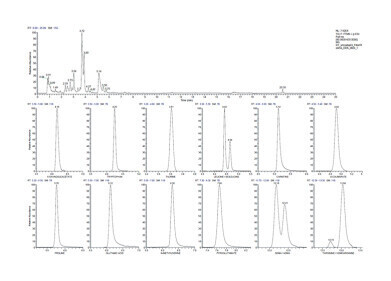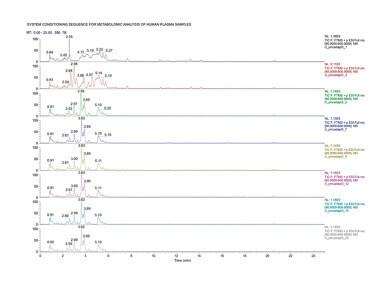-
 Figure 3: Non-targeted HRMS analysis of human plasma: total ion current of the plasma sample (top) and selected ion chromatograms of annotated metabolites < 5 ppm (bottom).
Figure 3: Non-targeted HRMS analysis of human plasma: total ion current of the plasma sample (top) and selected ion chromatograms of annotated metabolites < 5 ppm (bottom). -
 Figure 1: Improve your non-targeted profiling of polar metabolites in human plasma
Figure 1: Improve your non-targeted profiling of polar metabolites in human plasma
Liquid chromatography
Improve your non-targeted profiling of polar metabolites
Mar 26 2024
The fascinating aspect about non-targeted liquid chromatography analyses is the presence of unknown compounds, for example in biomarker research. A particular challenge for chromatography is then to find the balance between sensitivity and covering a broad spectrum of substances. Hydrophilic liquid chromatography (HILIC) is therefore especially suitable for such analyses containing polar compounds. It is a perfect match for mass spectrometry (MS) and has very good chromatographic performance. With this combination, non-targeted analysis is well suited to the screening of polar metabolites in human plasma.
This application note shows the non-targeted screening of polar metabolites in human plasma using a bioinert YMC Accura Triart Diol-HILIC column. The bioinert coated stainless-steel hardware is essential to achieve the highest sensitivity and chromatographic resolution of endogenous isomers.
For this analysis proteins contained in the plasma were precipitated with acetonitrile (3:1 v/v). After decanting and drying the sample, it was re-dissolved with acetonitrile/water (70/30) to the original concentration.
Due to the complex matrix a pre-conditioning step of the stationary phase can be necessary. By using the bioinert YMC Accura Triart Diol-HILIC column conditioning is already achieved after 4 runs (see Figure 2). Furthermore, an excellent retention stability is provided after conditioning.
The combination of the robust YMC Triart Diol-HILIC stationary phase with a cleaning step after each injection and an optimal equilibration step leads to a robust and reliable HILIC method.
Figure 3 shows the non-targeted screening of a human plasma sample and selected chromatograms of polar metabolites with low concentrations of < 5 ppm.
The developed HILIC method using a bioinert YMC Accura Triart Diol-HILIC column covers a wide range of polar compounds with an excellent peak capacity (baseline peak width of 0.25 min on average). In addition, the method achieves resolution of important critical pairs such as leucine and isoleucine and asymmetric and symmetric dimethylarginine (ADMA and SDMA respectively). Together with the simultaneous high sensitivity, this method ensures a reliable generation of biological hypotheses.
Download the application note to receive the full method details.
* Application data by courtesy of Sergey Girel, Institute of Pharmaceutical Sciences of Western Switzerland (University of Geneva), Geneva, Switzerland.
Events
May 11 2025 Vienna, Austria
May 18 2025 Tempe. AZ, USA
May 21 2025 Birmingham, UK
Jun 01 2025 Baltimore, MD, USA
Jun 15 2025 Bruges, Belgium

















